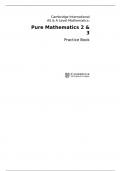Exam (elaborations)
Cambridge International AS & A Level Pure Mathematics 2 & 3 Practice Book
- Institution
- 123 University
Throughout this book you will notice particular features that are designed to help your learning. This section provides a brief overview of these features. ■ Differentiate products and quotients. ■ Use the derivatives of e x , ln x, sin x, cos x, tan x, together with constant multiples, su...
[Show more]



